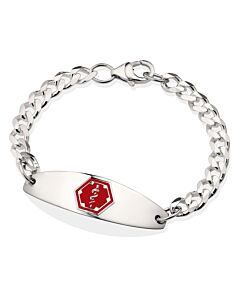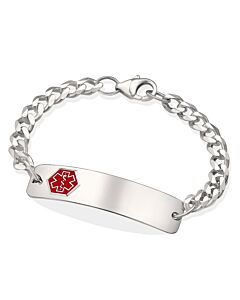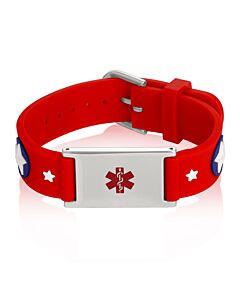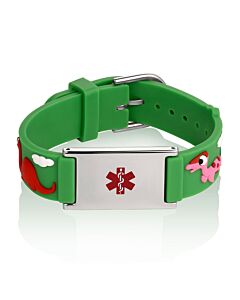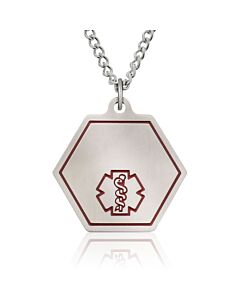

Medical IDs for Dairy (Milk) Allergy
A dairy allergy bracelet or necklace medical ID is recommended for adults and children diagnosed with dairy or milk allergies. Children are especially at risk if they are unable to communicate their dietary restrictions properly in the event of an emergency.
A dairy allergy is an abnormal response by the body's immune system to milk and products containing milk. When a person is allergic to milk, their body adversely reacts to the proteins found in dairy products. Reactions can range from mild to severe and can even lead to life-threatening anaphylaxis.
Milk allergies are most common in children, and avoidance of milk or items containing milk products is the only way to manage this type of allergy.
"If you have already had a severe reaction, wear a medical alert bracelet or necklace that lets others know you have a food allergy." - Mayo Clinic
Milk Allergy Symptoms
Individuals living with a dairy allergy must use caution and closely monitor ingredients before consumption, as many products contain various forms of dairy.
Although they are not the same, allergic reactions to dairy can be similar to lactose intolerance. Common symptoms of dairy allergy include:
- Diarrhea
- Nausea and vomiting
- Rash
- Hives
- Swelling of the lips and face
- Tightness in the throat
- Trouble swallowing
In an emergency, a medical ID can quickly alert others about the presence of dairy allergy and help avoid misdiagnosis, especially during an anaphylactic emergency. A dairy allergy bracelet could make the difference in getting the treatment you need.
Dairy Allergy and Anaphylaxis
Anaphylaxis is a severe allergic reaction that needs to be treated right away. A reaction can begin in minutes or appear hours later after eating food that contains dairy or milk products.
Epinephrine is the most effective treatment for anaphylaxis. Wearing a medical ID helps to alert others that an epinephrine auto-injector such as EpiPen is needed in case of severe allergic reactions to milk.
"Be prepared for anaphylaxis. Consider having your child wear or carry a medical alert bracelet to let others know of the allergy." - Kids with Food Allergies
What to Engrave on a Dairy Allergy Medical ID Bracelet or Necklace


Engraved information on a medical ID bracelet or necklace for a dairy allergy can be helpful to anyone responding to an emergency. When engraving a milk allergy alert ID, make sure that it contains accurate information that is easy to read, even in the most difficult situations like anaphylaxis.
- Wearer’s name
- Milk or dairy allergy
- Other medical conditions or autoimmune disorders that may or may not be related to dairy allergy – examples are asthma, diabetes, autism, etc.
- Epi-pen information – include an alert to use epi-pen and where it can be found (in pocket, bag)
- In case of emergency contacts
Dairy Allergy Bracelet & Wristband Options for Adults
95% of first responders check for a medical ID bracelet on a patient, so wearing a dairy allergy bracelet is a great idea to ensure you receive tailored medical treatment in an emergency.
Dairy Allergy Alert Bracelets for Kids
Since children can have difficulty communicating their dietary restrictions and important allergies, it is important for them to wear a dairy allergy bracelet.
Dairy Allergy Medical ID Necklace Options
If you prefer a medical ID necklace rather than a bracelet, here are some of our best-selling dairy allergy medical ID necklaces, available in a variety of metal types, styles, and chain types.
Why A Dairy Allergy Card isn’t Enough
In an emergency situation, possibly caused by an allergic reaction to dairy, relying on a wallet card with your critical medical information is an insufficient plan. It is best to wear a medical ID bracelet or necklace since emergency personnel are trained to first look for alert jewellery when responding to an emergency. Without wearing a bracelet or medical ID necklace, they will not be aware of your allergy card in your wallet.
Frequently Asked Questions
Should I wear a dairy/milk allergy bracelet?
Yes, if your allergy is severe then it is recommended to wear a medical ID bracelet. Check with your physician to receive their recommendation as well.
What is the medical alert symbol for dairy allergy?
On your medical ID bracelet or necklace, simply engrave “Dairy Allergy” or “ALGY: Dairy” along with any additional lifesaving information. There is no widely recognized medical alert symbol for dairy allergy.
Should I still carry a dairy allergy card if I wear a dairy allergy alert bracelet?
Carrying an expandable wallet card is an excellent addition to a medical ID bracelet/wristband or necklace. The additional space of an expandable wallet card allows you room to specifically list allergies, conditions, medications, emergency contact information, and more.
"Wear a medical ID bracelet or necklace. It lets others know of your allergy in an emergency. Also, keep a card in your wallet or purse that explains your allergy." - Asthma and Allergy Foundation



 - US
- US  - Canada
- Canada  - Australia
- Australia 


